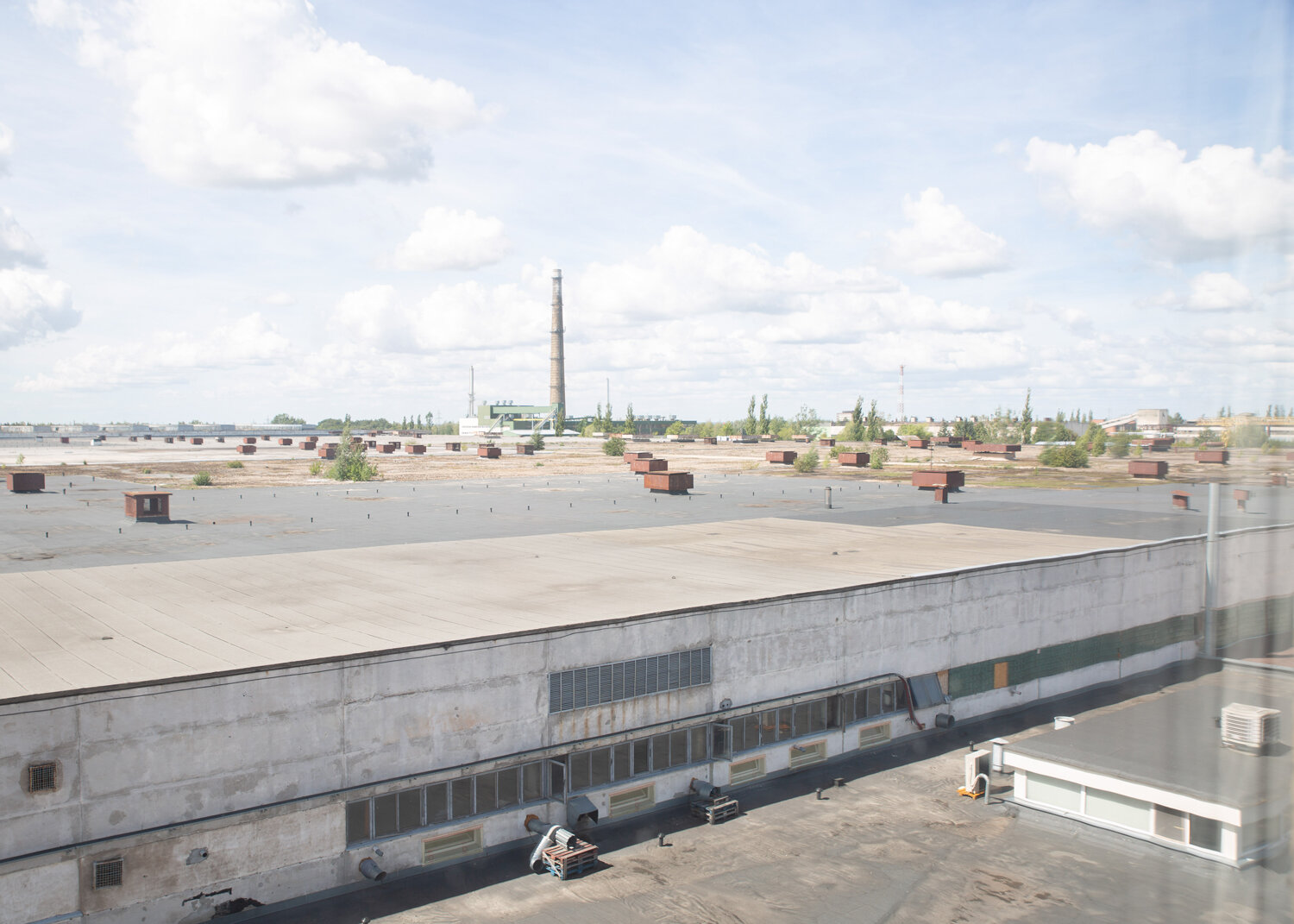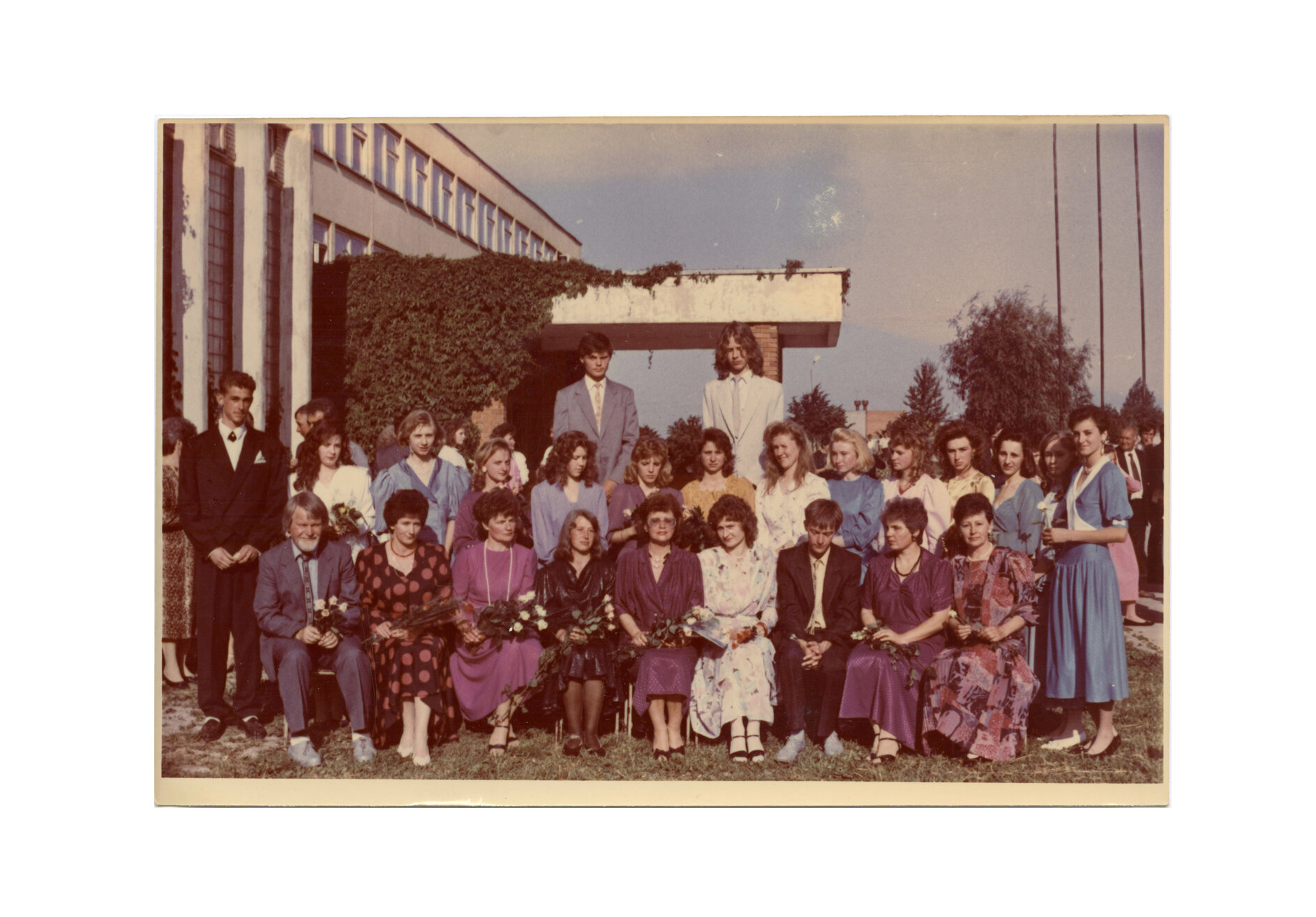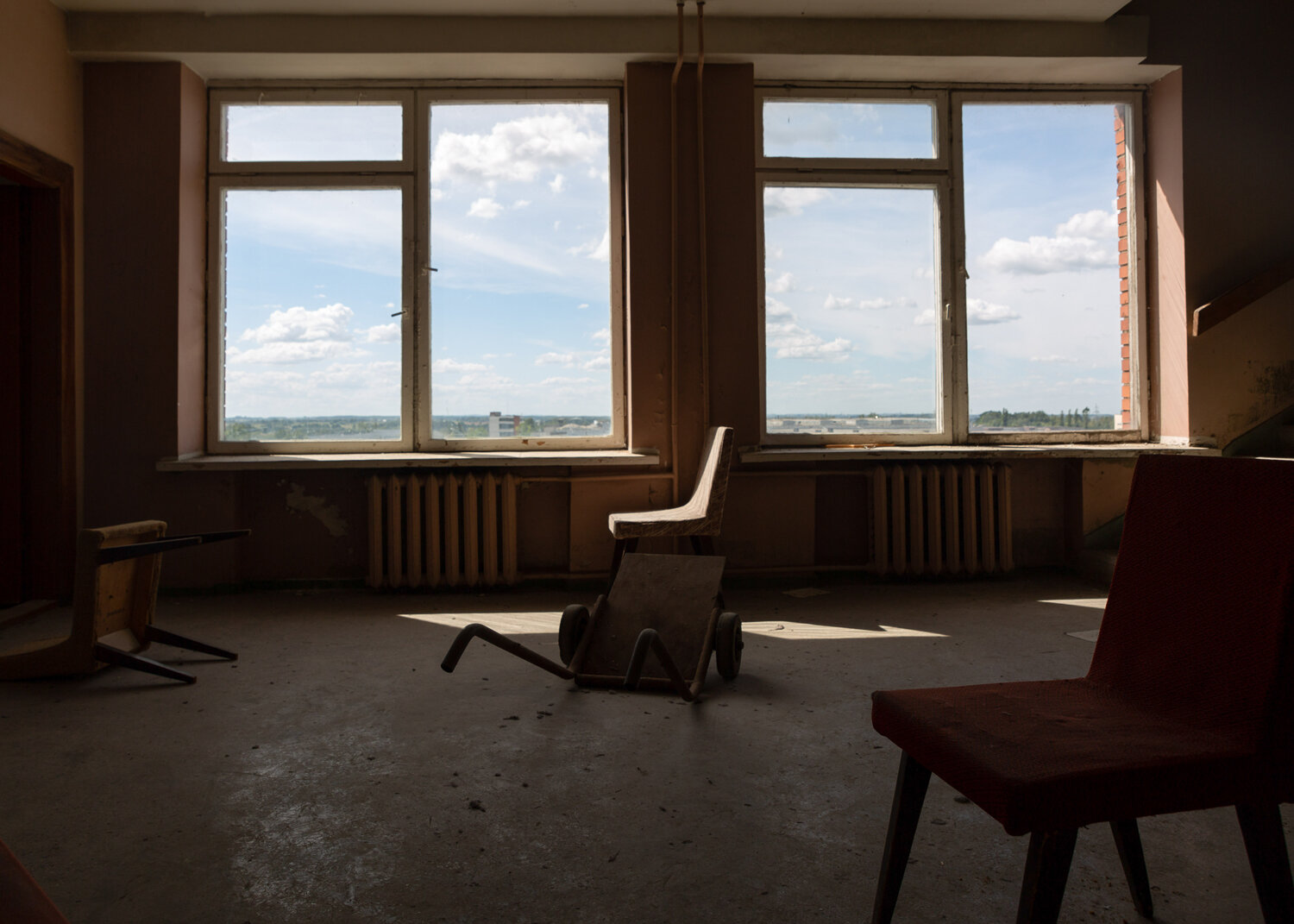

























Udarny trud consists of archival material that Korobkiewicz found in an abandoned textile factory in Alytus (Lithuania) with contemporary photos she took of the building and its interiors.
Born and raised in a borderland town in Eastern Poland near Lithuania, Korobkiewicz came across the factory when researching a project on aesthetics of post-socialist spaces in the summer of 2018. Upon entering the building, she encountered a wealth of neglected artefacts, textile samples, and personal photographs of the factory staff.
Alytaus Medvilnes Kombinatas was one of the largest textile companies in Lithuania and the Baltic States, responsible for the whole cycle of cotton manufacturing. Founded in 1969, the company went bankrupt in 2007, with the rising costs of production in Lithuania and the possibility of outsourcing labour from Asia cited as some of the reasons for its closure. At its peak, the enterprise employed approximately 6,000 people from all over Lithuania and it was crucial for the city’s industry.
Today, a dilapidated building and its monumental structure, cracked windows, and torn curtains represent the material remnants of the past. Concrete crumbling from the walls, abandoned rooms and broken furniture covered with layers of dust tell a powerful story of the rise and fall of a political system where labour was perceived as a right and a sacred duty.
Through juxtaposing the past and present of the textile enterprise set up during the socialist reign in Lithuania, Korobkiewicz poses questions about the meaning of labour in the previous and current political systems and explores social interactions shaping lives on the factory floor. She critically examines the cult of productivity and the role of the factory as a site of production and consumption through the archival photos that present the factory as a social centre and cultural platform of working-class communities.
Deriving from the Russian ‘уда́рник’, the title of the project refers to super-productive, enthusiastic labour that has been the backbone of the socialist conceptualisation of productivity. ‘Udarnik’ was a highly efficient worker exceeding the norm of required labour. Breaking records of productivity gained publicity and became a twofold mechanism to encourage other workers to increase their efficiency, and to create everyday heroes, raising the status of the best-performing labourers, with their photos honorarily displayed in factory halls and chronicles.
The project is accompanied by short essays by Natalia Domagala, a Polish-born, London-based writer and researcher.
Udarny trud solo exhibition at Centrala
8.02 - 27.03.2020
Unit 4 Minerva Works 158 Fazeley Street, Birmingham, B5 5RT
Opening Times: Wed - Sat, 12 - 8 pm

Background
Today, a dilapidated factory building in the Lithuanian town Alytus and its monumental, grey structure and cracked windows are the material remnants of the past. Concrete crumbling from the walls and broken furniture blanketed in dust tell a powerful story of the rise and fall of a political system where labour was perceived as a right and sacred duty.
Alytaus Medvilnes Kombinatas (Alytus Cotton Factory) was one of the largest textile companies in Lithuania and the Baltic States, responsible for the entire cycle of cotton manufacturing. Founded in 1969, when Lithuania was occupied by the Soviet Union, at its peak, the company employed approximately 6,000 people from across the region and was crucial for the city's industry. On 11 March 1990, a year before the formal dissolution of the Soviet Union, Lithuania became the first Baltic state to declare itself independent. In 1993, after the change of the system and reorganisation, the Alytus Cotton Factory was renamed to the joint-stock company Alytus Textile.
Rising costs of production in Lithuania resulted in relocation to Asia and more than a thousand workers in Alytus were made redundant. Following the privatisation of the company in the late 90s, further redundancies followed. The company went bankrupt in 2007.
Image © 2020 Paulina Korobkiewicz
words: Natalia Domagała

Work champions enjoy the respect of the whole nation
The socialist status quo led to the emergence of a new class of heroes - everyday workers who embody the values of the system: strength, endurance, enthusiasm, and readiness to rebuild their post-war nations. In contrast to capitalism, where man’s status is determined by his social origin and wealth, man’s status in a socialist society is determined by his work and personal abilities, bringing the rise of the cult of efficiency on the factory floor. The super-productive workers in the Soviet Union and its satellite countries were called ‘udarniks’. The term derives from the expression ‘udarny trud’ meaning ‘super-productive, enthusiastic labour’, which is often translated as strike labour, and udarnik as a strike or shock worker. In 1935, the Ukrainian miner Alexei Stachanov mined 102 cubic meters during his night shifts at a coal mine in the Donetsk Basin, performing 1475 per cent of the norm. Breaking records of productivity gained publicity and became a twofold mechanism used to encourage other workers to increase their efficiency, and to create everyday heroes, raising the status of the best-performing labourers, with their photos honorarily displayed in factory halls and chronicles.
‘I came back to rebuild Poland after the war damage. I know that this is new Poland, fair for the workers’ claimed Wincenty Pstrowski, one of the most famous Polish udarniks. He wrote an open letter to fellow workers in July 1947, describing his return to Poland following ten years of migration. ‘Since last May, I’ve been working as a hewer in the mine ‘Jadwiga’ in Zabrze. In February, I exceeded the norm by 240%, making 72,5 meters of pavement. In April, I made the norm of 82 meters of pavement, and in May I exceeded the norm by 270%, cutting 78 meters. I call for the competition from other miners. Who will cut more than me?’. Pstrowski quickly became a symbol - he was a model worker returning to his broken nation, putting effort into rebuilding the country and creating socialism. In October 1947, he exceeded the norm by 358% and became an example of a conscious socialist citizen of the Polish People's Republic, encouraging others to follow his lead. He received honours from the government and quickly became famous. The cult of the working class hero was written into the Polish People's Republic's constitution: ‘work champions enjoy the respect of the whole nation’, the Polish People's Republic also gave increasing practical effect to the principle: ‘from each according to his ability, to each according to his work’.
The roots of socialist competition reach back to 1928 when the first Five Year Plan was implemented in the USSR. Central planning was a foundational feature of the system: the universal right to work and ambition to share wealth produced by the workers as welfare for all led to introducing centralised redistribution. It required social ownership and control of productive resources along with the Party rules and central planning aimed to coordinate it. The first Five Year Plan was extremely ambitious, aspiring to build and modernise 1600 factories in four years - a year earlier than proposed. An urgent need to work nonstop and increase efficiency led to introducing socialist competition. It was a proven method to speed up the building process and realise the plan before the five-year deadline. Stalin himself claimed that competition should play the role of a lever by which the working class will shift the entire economic and cultural life of the country. For Stalin, socialist competition would transform work from the heavy and shameful burden into a matter of honour, glory, and heroism. This ideology applied across the Soviet Union. For instance, workers in gulags (forced labour camps) were required to take part in competitions aimed at exceeding the norms. Builders of Kanał Białomorski working towards an unattainable deadline set by Stalin participated in non-stop work sprints called ‘burze’ (’storms’) that could last even 24-48 hours. In gulags, a system of special rewards enabled the best performers to receive more food, better clothes, and a reduction in their sentences. To further encourage hyper-productivity, signs in gulag canteens read ‘for better workers, better food’.
For the most efficient workers, labour was a challenge that would eventually lead to satisfaction and fulfilment. According to socialist propaganda, udarniks worked better, faster, and cheaper than average, and found it effortless to achieve outstanding production rates. Their results were supposedly possible because of the right approach and effective time and work management. Despite being generally respected, udarniks were rarely liked by their co-workers. They earned more than average and held a reputation as racers hiking up the norms. Nevertheless, the workers were often reluctant to compete with one another - the competition would further increase the norms and force them to perform at an even more exhausting pace. If they failed to exceed the norm, their pay could worsen. The official party line was to not compromise the workers' safety through productivity, yet the culture of hyper-productivity didn’t encourage self-care. Wincenty Pstrowski, one of the most famous Polish udarniks, was also one of the first victims of the efficiency cult. The cause of his death in 1948 was a blood infection that allegedly emerged after he returned to work too soon following the extraction of his teeth. His wound got contaminated by the ashes and gases surrounding him in the mine. Wincenty was buried like a hero, with a celebratory funeral attended by thousands of people.
words: Natalia Domagała

Labour defines human life and dictates its everyday rhythm
There was laughter and excitement in the air when on a chilly December afternoon in 1983 a group of young female workers, mainly spinners and weavers, gathered in the factory’s cultural centre. Vigorous and proud, these women were celebrating a milestone in their careers - it was their anniversary at the textile factory in Alytus. Grinning and giggling, they could barely contain their enthusiasm. On that special night, they were joined by ex-workers (‘veterans’), teachers of the factory school, and supervisors. It was a moment they had been eagerly awaiting: they would be officially admitted to their working family. Celebrations commenced by watching a film about the factory, followed by inspirational speeches from the most efficient workers. What a joy it was to meet them and to listen to their stories! Young weavers had heard about their heroic productivity and could recognise some of the faces from the portraits of the most esteemed labourers hanging in the corridors. Their success had been recognised through prestigious medals and honours for their diligence, including the most important one - the Order of Lenin. They spoke passionately about how the factory developed across the years, and that the future would be even brighter. ‘You are the future!’ - one of the veterans exclaimed - ‘we create the future through the work of our own hands!’, he added and young workers clapped with delight. The managers and vice-director of the factory spoke next. They praised the young employees for their work and perseverance and handed them certificates confirming that they are now officially employed. High-profile representatives of Komsomol (The All-Union Leninist Young Communist League) joined the celebrations. New workers pledged a solemn vow on Komsomol’s banner embroidered with Lenin’s profile that they would work diligently. The evening continued with young workers dancing, chatting to the veterans, singing festive songs and declaiming poems about the factory.
Such social ceremonies had a symbolic value of admitting new employers to the factory community, serving as a rite of passage to mark the transition from an ordinary person into a socialist labourer. Introducing new rituals was an intrinsic part of the wider social engineering intending to install a new, puritan, socialist ethics. Party cadres aspired to create new moralities and to control populations. They modified the language to achieve standardised authoritative discourse, speaking of things that were yet to be created such as the working class or the ‘new socialist man’. Glorification and ritualisation of labour were at the centre of this discourse.
In the capitalist system, a factory is a place of production. Workers are expected to perform their contractual duties and leave at the end of the day to spend their leisure time engaging with market activities for pleasure. In state socialism, the factory simultaneously becomes a place of production and site of consumption. The nobility of work was one of the key principles and underlined political and social rights in the socialist system. Manual industrial labour was perceived as the means to the production of social wealth, thus the factory gained a status of the centre of working-class communities, contributing to the organisation of their daily lives. The workplace was deeply ingrained in the socialist welfare systems with the state providing goods and services. The factory was a social centre, a political hub and a cultural platform. Using terms such as ‘work collective’ evoked strong ties between the workers of a single plant where ‘the institution of employment played the role of the educator, controller and the point of emotional attachment’.
In most socialist countries labour constituted the highest value, both in the political and ethical system. The call: ‘He who does not work, neither shall he eat’ was paraphrased from biblical verses adopted by Lenin, which were also used in the Soviet constitution of 1918. Similarly, the 1952 constitution of the Polish People’s Republic stated that ‘work is the right, the duty and a matter of honour for every citizen. By their work (...) and the perfecting of methods of work, the working people of town and country add to the strength and power of the Fatherland, raise the level of prosperity of the people and expedite the full realisation of the socialist system. According to this ideology, the physical act of labour was tangible participation in building the new, prosperous socialist nation. For an ordinary worker, factory labour was the frontline of socialism. Labour was seen as the productive means to create a socialist man and simultaneously an indicator of their values and commitment to the country - scrupulous performance of their duties was considered a testimony to their patriotism.
words: Natalia Domagała